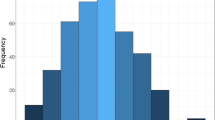Abstract
The debate about how best to measure social class in women complicates the analysis of socioeconomic inequalities in women’s health. The changing position of women in the labour market may mean that the commonly used “conventional” approach where a woman’s partner’s occupation is used to estimate her social class may no longer be appropriate. Alternative measures grade a woman’s class according to her own occupation or the most dominant class position in the household regardless of gender. We examined the association between “conventional” and personal measures of social class and all-cause mortality in a prospective study of women aged 39–79 years, without prevalent disease, living in the general community in Norfolk, UK, recruited using general practice age–sex registers in 1993–1997 and followed up for an average of 11.9 years. The risk of mortality increased with decreasing social class. There was little difference in the relationship between mortality and social class in women assigned using personal or partner’s occupation. When both measures were included in the same model, the effect of both measures was slightly attenuated. We found little difference between the different methods of assigning social class in women and mortality risk prediction. Both measures appear to share some common pathways through which they affect risk of mortality, although confidence intervals were large and neither measure was statistically significant. Further research is needed to disentangle their separate effects and pathways to mortality.

Similar content being viewed by others
Abbreviations
- EPIC-Norfolk:
-
European Prospective Investigation of Cancer and Nutrition in Norfolk
References
Krieger N, Chen J, Selby J. Comparing individual-based and household-based measures of social class to assess class inequalities in women’s health: a methodological study of 684 US women. J Epidemiol Community Health. 1999;53(10):612–23. doi:10.1136/jech.53.10.612.
Arber S. Comparing inequalities in women’s and men’s health: Britain in the 1990s. Soc Sci Med Health Inequal Mod Soc Beyond. 1997;44(6):773–87.
Krieger N, Chen JT, Selby JV. Class inequalities in women’s health: combined impact of childhood and adult social class—a study of 630 US women. Public Health. 2001;115(3):175–85.
Day N, Oakes S, Luben R, Khaw KT, Bingham S, Welch A, et al. EPIC-Norfolk: study design and characteristics of the cohort. European Prospective Investigation of Cancer. Br J Cancer. 1999;80(Suppl 1):95–103.
Shohaimi S, Luben R, Wareham N, Day N, Bingham S, Welch A, et al. Residential area deprivation predicts smoking habit independently of individual educational level and occupational social class. A cross sectional study in the Norfolk cohort of the European Investigation into Cancer (EPIC-Norfolk). J Epidemiol Community Health. 2003;57(4):270–6. doi:10.1136/jech.57.4.270.
McFadden E, Luben R, Wareham N, Bingham S, Khaw KT. Occupational social class, educational level, smoking and body mass index, and cause-specific mortality in men and women: a prospective study in the European Prospective Investigation of Cancer and Nutrition in Norfolk (EPIC-Norfolk) cohort. Eur J Epidemiol. 2008;23(8):511–22. doi:10.1007/s10654-008-9267-x.
Elias P, Halstead K, Prandy K. CASOC: computer-assisted standard occupational coding. London: HMSO; 1993.
Cox DR. Regression models and life tables. J R Stat Soc B. 1972;34:187–220.
Dosemeci M, Wacholder S, Lubin JH. Does nondifferential misclassification of exposure always bias a true effect toward the null value? Am J Epidemiol. 1990;132(4):746–8.
Arber S. Class, paid employment and family roles: Making sense of structural disadvantage, gender and health status. Soc Sci Med. 1991;32(4):425–36. doi:10.1016/0277-9536(91)90344-C.
Arber S, Ginn J. Gender and inequalities in health in later life. Soc Sci Med. 1993;36(1):33–46. doi:10.1016/0277-9536(93)90303-L.
Liberatos P, Link BG, Kelsey JL. The measurement of social class in epidemiology. Epidemiol Rev. 1988;10(1):87–121.
Kunst AE, Mackenbach JP. Measuring socioeconomic inequalities in health. Copenhagen: World Health Organization Regional Office for Europe; 1994.
Rose D, O’Reilly K. The ESRC review of government social classifications. Swindon/London: ESRC/ONS; 1998.
Rose D, Pevalin DJ. National statistics socio-economic classification: origins development and use. London: HMSO; 2005.
Rake K. Women’s incomes over the lifetime. London: Cabinet Office, The Stationery Office; 2000.
Klement C, Rudolph B. Employment patterns and economic independence of women in intimate relationships. Eur Soc. 2004;6:299–318. doi:10.1080/1461669042000231438.
Adler NE, Newman K. Socioeconomic disparities in health: pathways and policies. Health Aff. 2002;21(2):60–76.
Acknowledgments
We thank the participants and general practitioners who took part in the study and the staff of EPIC-Norfolk. Funding: EPIC-Norfolk is supported by research programme grant funding from Cancer Research UK and the Medical Research Council with additional support from the Stroke Association, British Heart Foundation, and Research Into Ageing.
Author information
Authors and Affiliations
Corresponding author
Rights and permissions
About this article
Cite this article
McFadden, E., Luben, R. & Khaw, KT. Different measures of social class in women and mortality. Eur J Epidemiol 24, 231–236 (2009). https://doi.org/10.1007/s10654-009-9332-0
Received:
Accepted:
Published:
Issue Date:
DOI: https://doi.org/10.1007/s10654-009-9332-0




